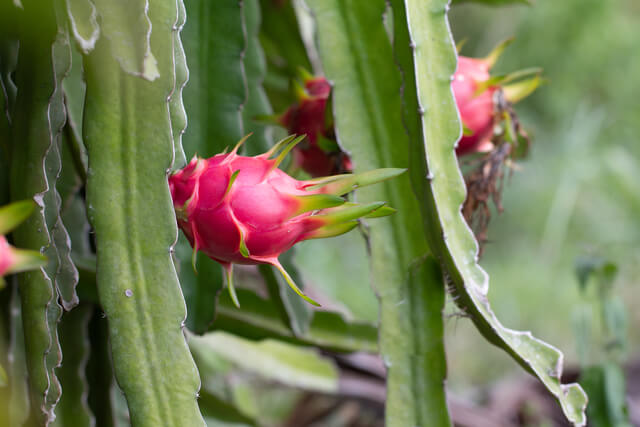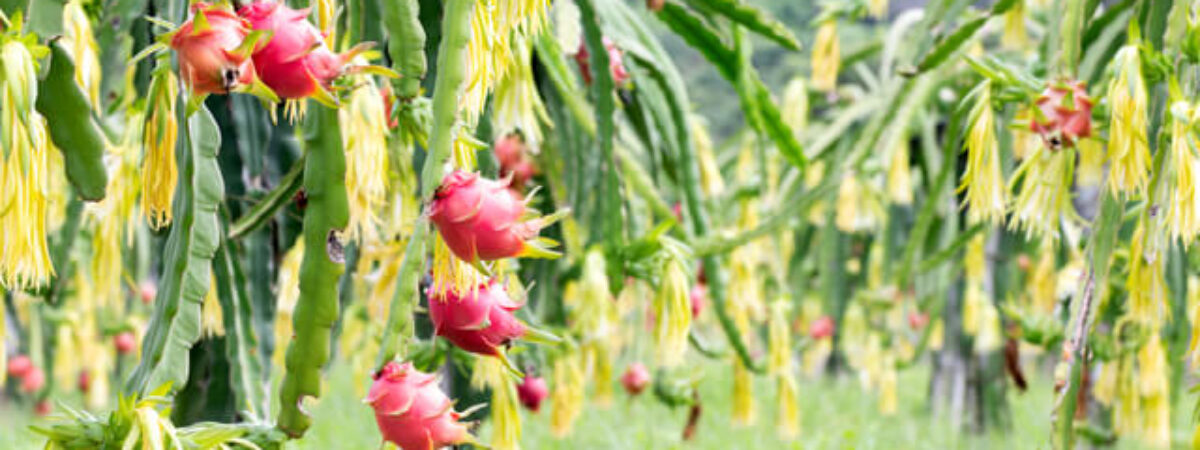Dragon fruit is scientifically known as Selenicereus undatus. They belong to the cactus species called Cactaceae. Dragon fruit is one of the most cultivated species of this genus.
In the cactus family, dragon fruit is an epiphyte which means it climbs on branches of trees. Though its origin still remains unresolved, it is believed to be native in southwest United States and Mexico.
It is mainly found in evergreen and deciduous forests especially in tropical and subtropical regions of America and Mexico. It is also called Pitaya or Pitahaya.
These fruits have succulent stems with white flesh and pink skin along with tiny black seeds. It can be eaten raw , in salads or blended with smoothies.
An amazing thing is that dragon fruit produces one of the largest flowers in the world called “night-blooming cereus,” that bloom for one night. It has a different tropical scent. Click To TweetThe taste of dragon fruit is a blend of sweet and savoury just like a kiwi fruit. It has a creamy texture which is why sometimes it is called strawberry pear. If you know how to eat a kiwi fruit then definitely you can eat this fruit as well.
An amazing thing is that dragon fruit produces one of the largest flowers in the world called “night-blooming cereus,” that bloom for one night. It has a different tropical scent.
Varieties
There are three common types of Dragon fruit and these are mainly grown in Australia.
Hylocereus undatus– This is a popular variety grown in Australia with pink skin and white flesh.
Hylocereus Megalanthus– It has yellow skin with white flesh
Hylocereus costaricensis– This is a slightly different variety with purple flesh and pink skin.

Climatic factors
As you know, Dragon fruit belongs to the cactus family so it is obvious that this plant loves a humid and warm climate and little water. These are subtropical plants.
Despite their ability to withstand heat, drought, humidity, and poor soil, they produce more delicious fruit when watered regularly and planted in rich soil.
Soil
They prefer sandy and well drained soil with a pH 7-8. They require at least 7-8 hours of sunlight. Mix the soil with compost and manure along with a dose of lime.
Water
These doesn’t require enough water so misting water will be enough, but make sure to keep the soil moist.
Climate
They prefer tropical and subtropical climates. They can tolerate mild winters, although they can tolerate brief bursts of cold, it is ideal to keep them above 10°F.
Fertilizer
The best part is that these are not heavy feeders. So heavy fertilization is not required, only you need to apply organic and low nitrogen fertilizer.

Harvesting of Dragon Fruit
It usually takes 30-50 days for Dragon fruit to grow fully and usually are harvested in May- July The best time to harvest is when the skin turns pink. Usually depending upon the local climatic condition, the fruit comes after a month of flowering.
Twist the fruit from the plant and pick it or else you can use secateurs to cut the fruit. The fruit doesn’t ripen further after plucking so make sure to pluck the fruit after it ripens.
You can keep the dragon fruit in the freezer for about two weeks and enjoy it with salads. The skin is not edible though.
Care for Dragon Fruit
Pruning
In extreme weather conditions, you can see some rotting signs, so it is better to cut down that part of the plant.
Dragon spots
Bacterial infection is common in these plants like stem rot mainly in poorly drained soil. A little gypsum could help and it’s always better to provide proper drainage for the soil .
Mites and Mealybugs
Though there is not much pest attack in dragon fruits, still there could be sometime when Mites and Mealybugs attack. So it’s better to control them with organic insecticide.
Fungal infections
Due to high heat or overhead watering there may be fungal infections on stem or fruit. Pruning is a best option or else if there is a severe infection then apply some organic fungicide.
Support for Dragon fruit plants
As dragon fruit plants are epiphytes they require support to climb. Hence you can use a wall or wooden post or trellis.

How to grow Dragon fruits in pots?
If you are someone who lives in cold areas, then growing dragon fruit in pots is a great option. By doing so, you can expose the plant to Sunlight when it is necessary.
With proper care, dragon fruit plants can grow up to a height of 5-10 ft and develop aerial roots. The pot should be 250 mm deep and 600 mm wide so that there will be enough space for the dragon fruit to grow.
Use a good amount of organic potting soil to feel the pot. It is better to prefer sandy, well-drained, and slightly acidic soil for growing dragon fruit plants.
Growing Dragon fruit outdoors
Dragon fruits possess a beautiful bright pink hue, so it is obvious that when you grow them outdoors, they will make your garden colorful. Click To TweetDragon fruits possess a beautiful bright pink hue, so it is obvious that when you grow them outdoors, they will make your garden colorful.
So the first thing you need to do is to remove the weeds and rocks from the place where you plan to plant them. Always choose a place where equal amount of Sunlight and shade reaches.
Then while preparing soil make sure to make it slightly acidic and proper drainage. Since it is an epiphyte, apply some support to the plant such as trellis or choose an area near fence
Make sure that the support you have provided is strong enough because dragon fruit plants bear fruits that are a bit heavy.
Conclusion
Now that you have read this article, you must have got a clear idea on how easy these Dragon fruit plants are to grow in your own garden.
So you should definitely add this nutritious fruit to your garden and enjoy its benefits with your family and friends.
You may also like to read
Best Organic Fertilizers to Feed Your Houseplants
How to grow persimmon tree? From Planting to Pruning, All in One Place!







One thought on “How To Grow Dragon Fruit- A Complete Guide”
buy generic cialis online cheap Cefixime Over The Counter